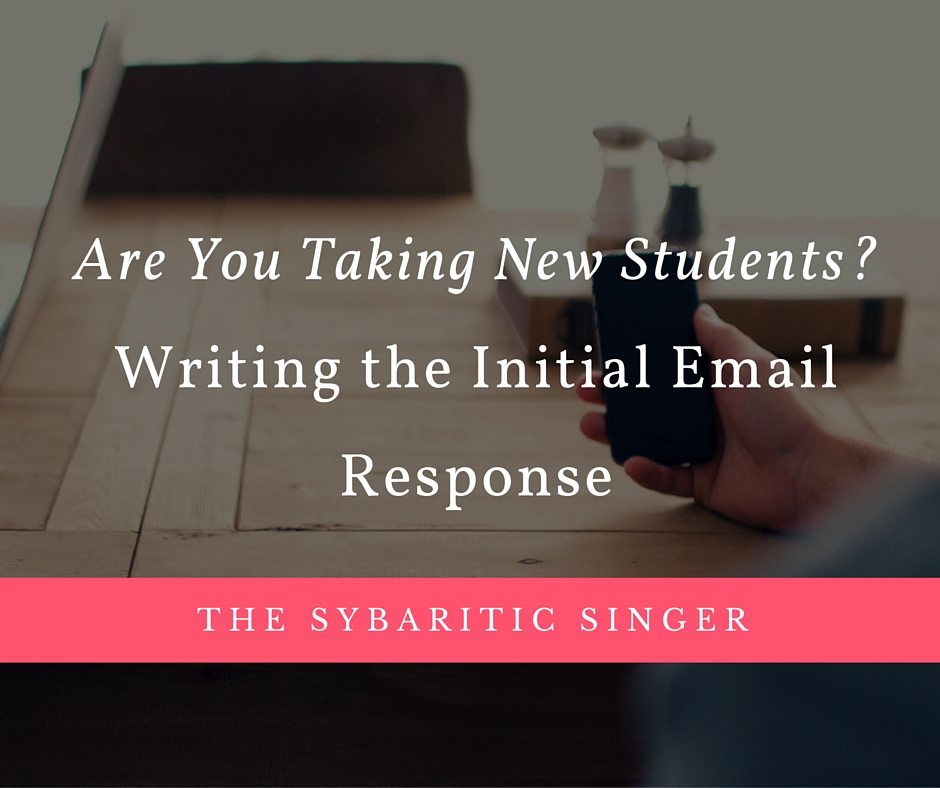Ding! There it is in your inbox…
Hi Ms. Diva,I’m emailing to see if you have any openings for voice lessons? I got your name from our friend Another-Diva-In-Town. My daughter, Diva-In-Training, is in 10th grade at A-High-School in Your-City. She has tryouts for choir coming up soon. If you could let me know if you are taking new students that would be great.Thank you,Soon-To-Be-Regular-Contact
Initial contact is made. A new client relationship is about to start. How you respond can set the tone for your whole time together. But if you run a busy teaching studio, responding to these emails can take up a lot of time and energy. That means it’s time to talk templates. Email templates.
Let’s Create Your Initial Email Response
There are three main parts of the initial email response: pleasant reply, policies, and call-to-action. Your goal is to make sure you’re giving the client a good idea of the expectations and benefits of lessons with you so that they can make the best decision for them and/or their child.
Charm the Heck Outta Them
Everyone wants to work with positive, responsive, and responsible people. Be formal enough in your email response to let them know you are a professional and that you take your business seriously. Much of your studio business can be based on word of mouth. It is in your best interest to speak highly of the person who referred you, if you can, in this email. In addition to speaking highly of the person who recommended you, show authentic interest and praise of your potential student. Parents will always tell you something about their child in the first email. Pick up on that and repeat it back to them. “Wow, it sounds like Susie is a really diligent student. That is such a great quality to have when beginning voice lessons. I’m looking forward to meeting her.” Make it immediately clear that it is your goal to be a positive force in their child’s life.
Attach Your Studio Policies
You have already painstakingly crafted your policies that outline the mission of your studio, how much you charge, the general scheduling overview, and more. They are just waiting to be attached to this email! Having your policies already in PDF form helps to cut down on the time it takes to respond to initial emails. Most every parent’s questions will be covered in your policies, if you have written them appropriately. We want to keep your initial email response short and sweet instead of responding with a tome on the nature of teaching music lessons. That’s why I believe in attaching the policies. Or, you can provide a link to them on your website, if you prefer. (I do not since I don’t want to publish my home address too freely.) In your email template, you simply have to have a straightforward, “I am currently accepting new students for the 201x-201x academic year. I have attached my studio policies to this email. Please take a look and let me know if you have any questions.”
Inspire Them to Take Action
Finally, you want your template to have a strong call to action. You want them to meet with you for an initial lesson! Depending on how full your studio is — or you want it to seem — you can add a bit of urgency here. I do not recommend this unless it’s actually true. You could try, “My teaching hours are Day X through Day Y from x:xx-x:xx but my schedule is filling up pretty quickly.” Scheduling can be a nightmare for a lot of families. One of the potential obstacles standing in the way of them signing up for lessons is that they are worried they cannot commit to a weekly schedule. But, you and I both know that once they or their child gets a sense of how great lessons can be, they’ll want to sign up on the spot. You can take this chance to get them to sign up for a Meet & Greet. We’ll get into the nitty-gritty of introductory lessons soon and how to automate their sign-up. But, write a call to action into your initial email template now!
There are plenty of extensions that allow you to create Gmail templates, if that would be useful to you. I’m obsessed with using Gmail’s “Inbox” and it does not currently offer templates. So, I just keep my initial email response template in “drafts.” A little copy, a little paste, et voilà! Remember to keep your initial email response positive, give them the best information to help them make a decision, and provide a call to action. That is the first part of your teaching studio prospective student funnel.
Looking to Revolutionize Your Teaching Studio?
There will be more exclusive content sent via email list only all month long covering things like:
- What to charge?
- How to release a student from your studio.
- Asking for feedback.
- Planners for voice teachers and for students.
Sign up now and make sure to select the Sybaritic Singer news option!


